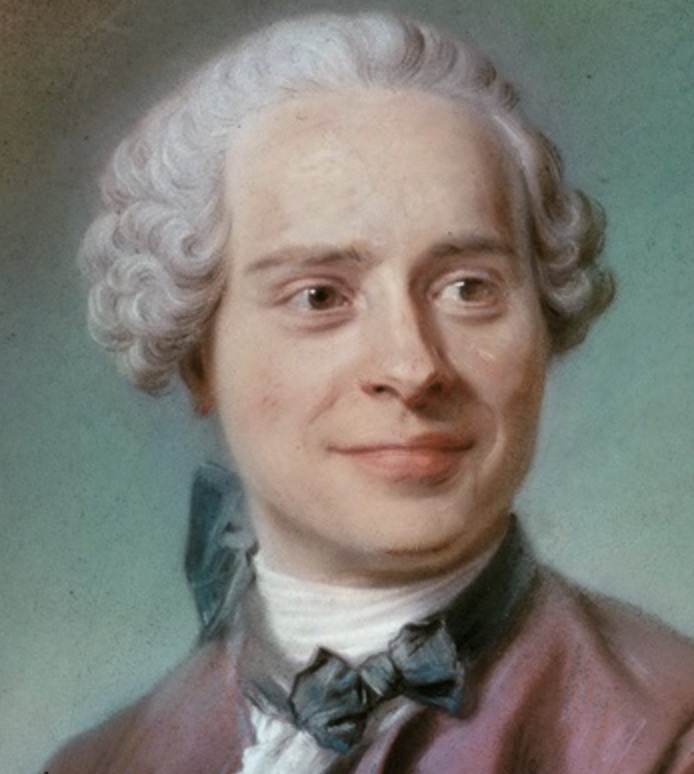
Jean-Baptiste le Rond d’Alembert was born on November 16, 1717, in Paris, France to writer Claudine Guérin de Tencin and artillery officer Louis-Camus Destouches. Shortly after his birth, Jean-Baptiste was abandoned by his mother at the Church of Saint-Jean-le-Rond, where a foundling wheel was used for deserted infants. The wheel did not turn, indicating that someone intended to come back for the child, but when no one claimed him, he was placed in an orphanage for foundling children. In accordance with custom, he was named after the patron saint of the church, Saint Jean le Rond. When Jean Le Rond’s father, Louis-Camus, returned to Paris he tracked down his son and placed him in the care of Mme Rousseau, the wife of a glazier.
Louis-Camus Destouches arranged for his son to attend a private school for his elementary education. When Destouches died n 1726, he left enough money for the Destouches family to enrol 9-year-old Jean in the Jansenist Collège des Quatre Nations, where Jean eventually acquired the surname, “d’Alembert”.
It was at the Collège des Quatre Nations that Jean d’Alembert displayed a flair for mathematics. Although his mathematics teacher, Professor Carron, encouraged d’Alembert’s mathematical interest, most of what Jean learned came from his immersion in the excellent mathematics library at the Collège. In spite of the faculty’s urging him to pursue an ecclesiastical career, d’Alembert was more interested in philosophy and mathematics, and graduated in 1735 with a baccalauréat en arts. Recognizing that mathematics was not likely to provide an adequate livelihood, d’Alembert spent the next three years in the study of law, and in 1738 was a qualified lawyer.
The lure of mathematics continued to tug at d’Alembert’s deepest inclination and In July 1739 he made his first foray into the mathematical domain with a communique addressed to the Académie des Sciences. In that paper he identified some errors in the widely accepted Analyse démontrée that been a standard treatise in French mathematics for more than three decades. He followed this in 1740 with a substantial publication on the mechanics of fluids. On the strength of his early work, including some new contributions to integral calculus, he was elected in 1741 to the Paris Academy of Science. In his publication of Traité de dynamique in 1743, d’Alembert reformulated Newton’s laws of motion as mathematical laws rather than empirical postulates. In the next year, he published Traité de l’équilibre et du mouvement des fluides in which he applied his laws of motion to fluid dynamics and elasticity.
A short time after this flurry of mathematical publications d’Alembert met Madame Geoffrin, a wealthy woman and benefactor who helped introduce him to the life of high living among the intellectual elite of 18th-century Paris. In his new role as a celebrated intellectual, d’Alembert met and collaborated with Denis Diderot on the famous “Encyclopédie, ou dictionnaire raisonné des sciences, des arts et des métiers” (Encyclopedia, or a Systematic Dictionary of the Sciences, Arts, and Crafts). The 28-volume Encyclopédie was a groundbreaking project that aimed to compile and disseminate knowledge across a wide range of subjects, challenging established authorities and promoting Enlightenment ideals. D’Alembert wrote extensively for the mathematics and science sections of the Encyclopédie. This further enhanced his reputation as an eminent scholar of international celebrity.
In 1764, Frederick II of Prussia invited d’Alembert to become the president of the Berlin Academy and Catherine the Great of Russia asked d’Alembert to tutor her son, but he declined both offers. The next year, following a prolonged illness, Jean d’Alermbert complained that he was no longer able to concentrate on mathematics. In a letter to Jean-Louis Lagrange, written in 1777, he lamented:
What annoys me the most is the fact that geometry, which is the only occupation that truly interests me, is the one thing that I cannot do. All that I do in literature, although very well received in our public sessions of the French Academy, is for me only a way to fill the time for lack of anything better to do.
In the latter years of his life, d’Alembert confined his writings to literature and philosophy as his health continued to decline and he died of what may have been bladder cancer on October 29, 1783, in Paris, at the age of 65. Jean-Baptiste le Ronde d’Alembert was associated with the Enlightenment, a cultural and intellectual movement that emphasized reason, science, and skepticism of traditional authority. He supported a more secular and rational approach to societal issues. However, unlike some of his contemporaries, he was more moderate in his political views, seeking to avoid extreme revolutionary changes. Jean-Baptiste le Rond d’Alembert’s legacy is marked by his contributions to mathematics, his role in the Enlightenment’s intellectual movement, and his work on the Encyclopédie, which remains a significant cultural and historical achievement.
